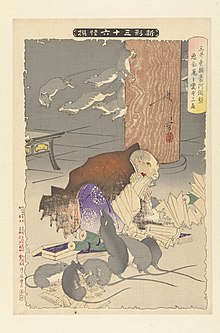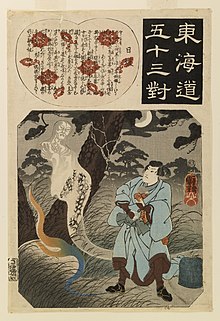The word mogwai is the transliteration of the Cantonese word 魔怪 meaning 'monster', 'evil spirit', 'devil' or 'demon'.
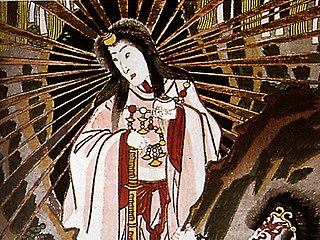
Yūrei are figures in Japanese folklore analogous to the Western concept of ghosts. The name consists of two kanji, 幽 (yū), meaning "faint" or "dim" and 霊 (rei), meaning "soul" or "spirit". Alternative names include Bōrei (亡霊), meaning ruined or departed spirit, Shiryō (死霊), meaning dead spirit, or the more encompassing Yōkai (妖怪) or Obake (お化け). Like their Chinese, Korean, and Western counterparts, they are thought to be spirits barred from a peaceful afterlife.

In Japanese traditional beliefs and literature, onryō are a type of ghost believed to be capable of causing harm in the world of the living, injuring or killing enemies, or even causing natural disasters to exact vengeance to "redress" the wrongs it received while alive, then taking their spirits from their dying bodies. Onryō are often depicted as wronged women, who are traumatized, envied, disappointed, bitter, or just furious by what happened during life and exact revenge in death. These kinds of ghosts appears extremely vengeful, ruthless, heartless, brutal, cruel, deranged, egotistical, selfish, bloodthirsty, and cold-hearted.

There are many Malay ghost myths, remnants of old animist beliefs that have been shaped by Hindu-Buddhist cosmology and later Muslim influences, in the modern states of Brunei, Indonesia, Malaysia, Singapore and among the Malay diaspora in neighbouring Southeast Asian countries. The general word for ghost is hantu, of which there exist a wide variety. Some ghost concepts such as the female vampires pontianak and penanggal are shared throughout the region. While traditional belief does not consider all ghosts as necessarily evil, Malaysian popular culture tends to categorise them all as types of evil djinn.
The glaistig is a ghost from Scottish mythology, a type of fuath. It is also known as maighdean uaine, and may appear as a woman of beauty or monstrous mien, as a half-woman and half-goat similar to a faun or satyr, or in the shape of a goat. The lower goat half of her hybrid form is usually disguised by a long, flowing green robe or dress, and the woman often appears grey with long yellow hair. A sighting of the glaistig is rare, but the loud cries and wails would often be heard.

The Krasue is a nocturnal female spirit of Southeast Asian folklore. It manifests as the floating, disembodied head of a woman, usually young and beautiful, with her internal organs still attached and trailing down from the neck.

In a broad sense, Goryō is an honorific for a spirit, especially one that causes hauntings, and the term is used as a synonym for onryō. In a narrower sense, it refers to a person who was a noble or accomplished person in his or her lifetime, but who lost a political power struggle or died prematurely from an epidemic or other disease, becoming a onyō that brings pestilence or famine and is later enshrined as a kami in Shinto shrines. For example, the "Sandai Jitsuroku" mentions that six Shinto shrines were dedicated to the worship of goryō, which were the spirits of those who died from non-natural causes. Later on, two more shrines were added, bringing the total to eight.

Chinese folklore features a rich variety of ghosts, monsters, and other supernatural creatures. According to traditional beliefs a ghost is the spirit form of a person who has died. Ghosts are typically malevolent and will cause harm to the living if provoked. Many Chinese folk beliefs about ghosts have been adopted into the mythologies and folklore of neighboring East Asian cultures, notably Japan, Korea, and Vietnam. Beliefs about ghosts are closely associated with Chinese ancestor worship, where much have been incorporated into Buddhism and in turn influenced and created uniquely Chinese Buddhist beliefs about the supernatural.
In Indonesian mythology, a sundel bolong, is a mythical ghost from the archipelago which is a woman with beautiful long black hair and a long white dress. The myth is closely linked to prostitutes, meaning a "prostitute with a hole in her", in reference to the large hole which is said to appear in her back.
Phi Tai Hong is a ghost of Thai folklore. It is the vengeful and restless spirit of a person who suddenly suffered a violent or cruel death.
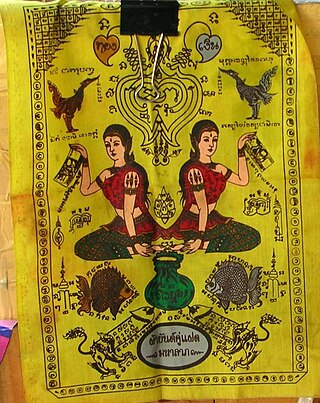
Thai folklore is a diverse set of mythology and traditional beliefs held by the Thai people. Most Thai folklore has a regional background for it originated in rural Thailand. With the passing of time, and through the influence of the media, large parts of Thai folklore have become interwoven with the wider popular Thai culture.
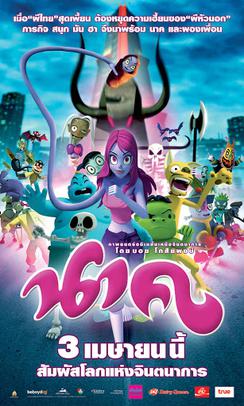
Nak is a Thai computer-animated dark fantasy horror film that was released on April 3, 2008 and aired on TV in Thai PBS Kids.

Belief in ghosts in Thai culture is both popular and enduring. In the history of Thailand, Buddhist popular beliefs intermingled with legends of spirits or ghosts of local folklore. These myths have survived and evolved, having been adapted to the modern media, such as Thai films, Thai television soap operas, and Thai comics.
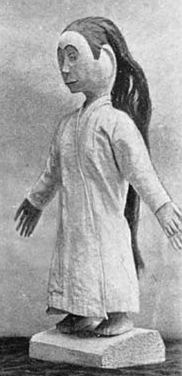
The langsuyar, also lang suir or langsuir, is a female revenant in Malay and other mythologies in the Malay archipelago. The word is derived from the Malay word for eagle (helang).

The night hag or old hag is the name given to a supernatural creature, commonly associated with the phenomenon of sleep paralysis. It is a phenomenon which a person feels during a presence of a supernatural malevolent being which immobilizes the person as if sitting on their chest or the foot of their bed. The word "night-mare" or "nightmare" was used to describe this phenomenon before the word received its modern, more general meaning. Various cultures have various names for this phenomenon and/or supernatural character.

Ghostlore refers to the body of folklore and traditional beliefs surrounding ghosts and hauntings. These tales often feature spirits of the deceased who are believed to linger in the physical world, either to communicate with the living or to seek vengeance for past wrongs. Ghostlore is a widespread phenomenon, with stories of hauntings and ghostly encounters found in cultures around the world.
